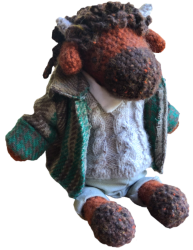
Grace Hawkins’ visual art practice primarily employs craft and textile materials to explore the space between the domestic and the wild, human and beastial, stories and reality, with a particular interest in creature making and the symbols and narratives hung on their little bodies.
These creatures unlock a collection of meaning, connected deeply with myth, representations of metamorphosis and artistry, women’s work, and spitting in the face of authority. Grace’s puppets are affectionately known as “children”, whose soft, insectoid bodies are concerned with the overlooked and abject, re configured into something comforting. Her knitted works also hold a similar space , recontextualising depictions of mythic and monstrous women in western art history into tapestries. These women are reclaimed and re situated in a lineage of women’s work, both familiarised and fragmented. The historical exclusion of craft work, not only soft, domestic skills but also practical, hands-on making, from the fine arts space has driven Grace to embrace this language, which has shared DNA with the weaving of yarns, with the spinning of stories, with transporting the audience to another realm of being.
Anthropomorphism, allows for a greater complexity of meaning, and more explicit allegories of the human condition, while also reflecting on our own idea of personhood. In cocooning humanity in the mythologies and narratives of other creatures, you both kill and vivify the individual. The characters are becoming both less than and more than itself in isolation. There is an inescapable whimsy in the anthropomorphic, a facet the artist both embraces and attempts to subvert in her practice. The childlike familiarity with which one approaches C S Lewis or Beatrix Potter is lovingly extended towards the monstrosity of the minotaur and sphynx. Hawkins uses the complex palette of myth and anthropomorphism to explore notions of personhood, femininity and reclamation in her practice.
